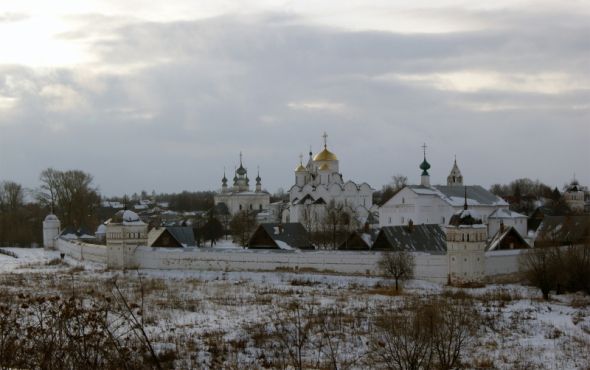Intercession (Pokrovsky) Monastery
- Address:
- Suzdal, Pokrovskaya st., 76
- GPS:
- 56.42934062, 40.43746337
- Phones:
- +7 (49231) 2-06-09
The Intercession (Pokrovsky) Monastery was founded in 1364, but from this initial period, practically nothing was preserved. All that has come down to our days, mainly refers to the first half of the 16th century and a later period, and is associated with dramatic events in the life of the Grand Duke's family – the Moscow prince Basil III. He decided on an unheard violation of church rules – a divorce with his first wife Solomoniya Saburova, who after twenty years of marriage never gave birth to children. She came from an old boyar family of Moscow. During the 1508-1518 Basil III richly equiped the Suzdal Intercession monastery, while seeking a divorce from the church and looking for a future new wife – Pole Elena Glinskaya. In 1625 Solomoniya Saburova was forcibly tonsured into a nun (under the name of Sofia) and exiled to the Intercession Monastery.
Since then, the Intercession Monastery has become a place of exile for the disgraced tsarinas and women of noble boyar families. Among its nuns and elders – the daughter and niece of Ivan III, the wife of Prince Vladimir Staritsky – Eupraxia, the wife of Tsarevich Ivan – Evdokia, one of the wives of Ivan the Terrible – Anna Vasilchikova. The last crown princess of the monastery was Evdokia Lopukhina, the wife of Peter I, accused of plotting against the tsar. Here, many aristocratic spiritual prisoners ended their lives. In the monastery were found the burials of representatives of families of Nagies, Gorbaties, Shuiskies and others (more than 20 eminent nuns). In 1934, in the tomb of the Intercession Cathedral, under a small white stone slab (without an inscription), the director of the Suzdal Museum A.D. Varganov had uncovered a children's burial. In the wooden deck, "remnants of semi-decayed silk fabric without bone remains" were found. This burial began to be connected with the rumors that were going on in the 16th century, about the birth at the monastery, allegedly, of Solomoniya's son George, whom she gave to the upbringing to faithful people, having arranged a fictitious burial. In 1650 Solomoniya Saburova was recognized as a saint (Sofia of Suzdal), her tomb, "exuding miracles", attracted pilgrims and enriched the monastery treasury. The monastery received the richest deposits and new landed estates with thousands of serfs. It was visited repeatedly by royalty.
The main temple of the monastery and at the same time a tomb for noble nuns was the Intercession (Pokrovsky) Cathedral. It is a majestic three-domed temple in the design of which the decorations of the white-stone Nativity Cathedral of the Suzdal Kremlin were used (arched-columnar belt, lush portals that are clearly visible through the open arcade of the gallery). The interior decoration of the temple was very ascetic: the floor was paved with black ceramic tiles, the walls were not painted. But the magnificent icons and artistic sewing made the interior exquisite.
The tented bell tower is connected to the cathedral with the gallery. It is a rare monument of the ancient Russian architecture: its lower two-tiered part, dating back to 1515, was an octagonal pillar-shaped church "under the bells" (i.e. completed with a tier of belfry). The tent of the modern bell tower appeared at the end of the 17th century.
The original architecture of the cathedral is repeated in the Holy Gates, built, like other buildings of the monastery, commissioned by Basil III around 1518. It is a four-sided tower with two asymmetrical arched spans over which the gallery and the elegant three-headed gate-church of Annunciation rise. The decorations of the facades of the building resemble carving on wood, giving to its appearance a sincere simplicity and elegance.
To the north of the cathedral is the Refectory Church of the Holy Conception, built in 1551. Outside, it is designated only by a small head, and its base is formed by the refectory hall of the one-pillar chamber, which impresses with its vaults. To the south-west corner of the refectory in the 16th century was attached a rare in its form hexagonal belfry ("chasozvonya").
The monastery yard was bordered by rows of cells, some of them already at the end of the 16th century were of stone. There were also some service buildings – a brewery, a cellar, a kitchen, a glacier. In the south-west corner of the monastery, there preserved the brick building of the beginning of the 17th century, restored in 1957 by A.D. Varganov, – "the order chamber", under which there was an underground prison. In the building today is housed a museum exposition with genuine exhibits, recreating the interior of the order hut of the 18th century, as well as telling about the history of the Intercession Monastery, one of the oldest aristocratic monasteries of Russia.
Monastic life in the convent resumed in 1992. The Intercession (Pokrovsky) Monastery became the first revived monastery in Suzdal. Under its care the monastery took a city house for the elderly and disabled.
On the territory of the current convent there is a unique hotel "Pokrovskaya", the rooms of which are in 11 chopped houses – copies of Russian huts of the 19th century.
 Tourism portal of the
Tourism portal of the


